|
Wakefield competition requires some of
the highest skill level in all of modeldom with regards to aircraft structure and covering
details, engine and fuel system tuning, dethermalizer setup, trim for uncontrolled flight
during launch, transition, glide, and dethermalized phases. That. of course, is not to
minimize the skill sets required for other realms of model aircraft, but it seems to
me Wakefield requires expertise in all disciplines in order to be a consistent winner.
The 12th Nordic Championships we held in winter on
Lake Vasijarvi at Tampere, Finland - above the Arctic Circle, at
61.5°N. This is a robust bunch of modelers! Was this the greatest ever contest?
Results show terrific standard in Nordic Country flying?

Reported by R. Hyvarinen
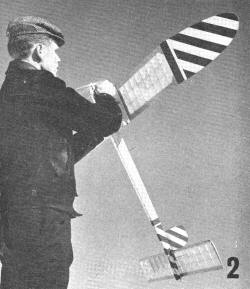 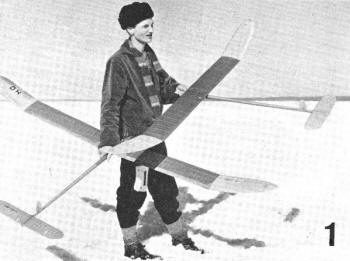 1. Pentti Ella with his beautiful A/2s came second
in fly-off due to line breaking immediately after launch. 1. Pentti Ella with his beautiful A/2s came second
in fly-off due to line breaking immediately after launch.
2. Osmo Niemi flew his "Pulteri" to second place in power. Model is much admired for
performance and simplicity.
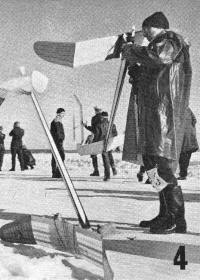
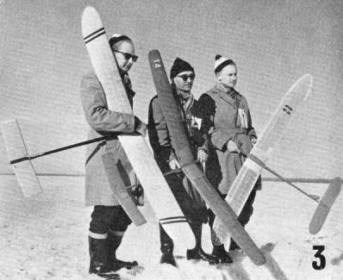 3. The world-famous trio of Hansens, from left,
Hans, Borge and Arne. Could do little against still-air models underprevailing conditions. 3. The world-famous trio of Hansens, from left,
Hans, Borge and Arne. Could do little against still-air models underprevailing conditions.
4. Rolf Hagel preparing for another maximum, reserve model in front. Note the long
moment arms and double fins"
5. Sweden's well-known Rune Johansson with his beautifully made model, lost 8 seconds
with his first flight to drop him to 4th place.
6. Finland's 2,700 seconds Wake-trio before the first extra flight. From left Hyvarinen,
Aalto and Hamalainen.
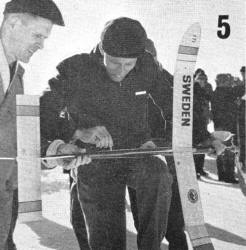
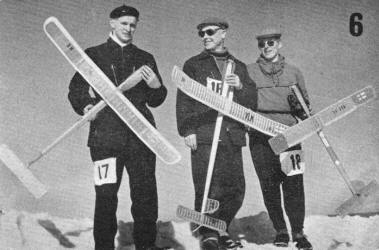
Since 1945, Scandanavian modellers have competed in the Nordic Countries Champs, thus
creating the A/2 Class in the late Fourties. Some years later the Wakefield and F.A.I.
power classes were included in these meetings. The high standard the Nordic Country teams
have produced at the World Champs, and other International meetings have in no small
way been due to these annual meetings as well as the all-the-year-round flying programmes
run in these countries.
For the second time the Championships were held in winter, this time over the huge
frozen Lake Vasijarvi at Tampere, Finland on March 20th. Due to the unusual date, the
Danes could only send three men, the world famous A/2 trio of Hansens; Arne, Borge and
Hans and they were delayed by ice in the Baltic. Norway has yet to reach the International
standard in Wake, so they only sent A/2 and Power teams but both the Swedes and the hosts
country Finland had full teams.
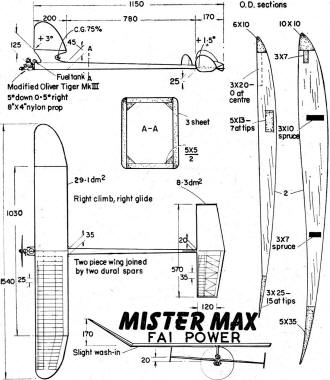
Rolf Hagel's winning power model, times were 900 + 210 + 240 + 270.
Same model also won 1960 Swedish meeting with 900 + 5 x 180 seconds
An almost two mile long motor road had been ploughed to the centre of the lake, where
everything including tents for models and control were ready at sunrise, as the competitors
came out to trim. Events started at 8 o'clock with one hour rounds divided into three
20 minute periods for each competitor to make his flight. The sun was shining from a
clear blue sky, and morning haze hung still above the ice. Beginning with a faint breeze
and a temperature of about minus 2 deg. centigrade the circumstances were set for a splendid
day of flying, and results were to prove it one of the finest contests ever known.
The first round saw 17 maxes for the 27 competitors including all the Finns. Thermal
activity was non-existent and remained so all the day. Sometimes only very weak lift
would make up to 20 seconds increase in the A/2 times. Thus the competition really gave
true performances of the models, eliminating entirely the thermal lottery so common at
summer time. During the second round the wind got up to 3-5 metres/second (780 feet per
minute) remaining so for the rest of the day. Flyers had to make 1-1 1/2 mile recoveries
for their models, and as the ice was covered with 5 inches of snow, those without skis
were quite exhausted towards the afternoon.
After the second period the Finns were still having perfect maximums, and such conditions
called for good still air models to make maximums, so it was no wonder that the Hansens
were eliminated from the top places with their strong dihedralled low aspect ratio gliders
made especially for the windy conditions always prevailing in Denmark. However, they
were utilising the weather for trimming models to ultimate performance, but as one of
them jokingly said "It isn't very economical to go trimming models abroad."
As the third period clearly demonstrated, the standard in Wakefield and Power was
very high. In the Power class, only errors, such as fuel running out too early, could
prevent competitors from making maxes. It would seem that the F.A.I. will have something
to do with this class, e.g. limiting the motor run to 10 seconds to make some sense of
the 3 minute maximum. This third period saw two Finns dropping slightly from maxes with
their A/2s. Then followed a one hour break for a meal while the numerous public who combined
their Sunday skiing with sightseeing the meeting, could see some fine practice towings
by the Finnish A/2 experts, kiting their models overhead and holding them on the line
indefinitely. Sweden's Rolf Hagel was also trimming his new 1·5 c.c. power model, which
created some interesting high speed acrobatics having still to gain its ultimate trim.
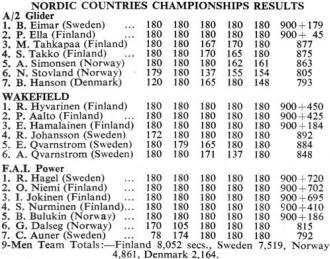 The wind had dropped slightly at the beginning
of the fourth period, and the maximum duration flights prevailed through to the fifth
and final period with the final result that there were 900 seconds men in every class.
Bror Eimar of Sweden and Finland's Pentti Ella in A/2, all the three Finnish Wakefield
flyers, Aalto, Hamallainen and Hyvarinen. Power saw five men with perfect maxes viz.
the three Finns, Vienni, Jokinen and Nurininen Sweden's Hagel and Bulukin from Norway.
Team placings were already solved, Finland making clear victories in all the classes
and with really astounding results. A/2; 2652 seconds, Wakefield and Power each with
perfect maximums of 2,700 seconds. Victory went clearly to Finland by missing only 48
seconds of the possible 8,100 seconds in the 3 classes (45 flights), more than 500 seconds
ahead of Sweden. The Finns had every reason to be extremely satisfied with their record
performance. The wind had dropped slightly at the beginning
of the fourth period, and the maximum duration flights prevailed through to the fifth
and final period with the final result that there were 900 seconds men in every class.
Bror Eimar of Sweden and Finland's Pentti Ella in A/2, all the three Finnish Wakefield
flyers, Aalto, Hamallainen and Hyvarinen. Power saw five men with perfect maxes viz.
the three Finns, Vienni, Jokinen and Nurininen Sweden's Hagel and Bulukin from Norway.
Team placings were already solved, Finland making clear victories in all the classes
and with really astounding results. A/2; 2652 seconds, Wakefield and Power each with
perfect maximums of 2,700 seconds. Victory went clearly to Finland by missing only 48
seconds of the possible 8,100 seconds in the 3 classes (45 flights), more than 500 seconds
ahead of Sweden. The Finns had every reason to be extremely satisfied with their record
performance.
On the previous evening, team-managers had made an agreement on the inevitable fly-off.
Both Sweden and Finland were already experienced in the new F.A.I. rule of continuing
3 minute flights and whilst for A/2 it seems to be satisfactory, in Wakefield and especially
in Power it might even take weeks of continuous flying to determine the winner under
good conditions. So it was decided to increase the maximum time by 30 seconds every flight.
The first flight decided the winner in A/2 for Ellas' line broke immediately after
launch, and the model clocked a mere 45 seconds from 40 feet height. So Eimar had no
difficulties in making 179 seconds to become the individual winner. In Wakefield the
three Finns decided to launch simultaneously to eliminate the possible risk of lift or
a downdraught. Hamalainen didn't make his usual height during the climb and with only
184 seconds he dropped aside, Aalto and Hyvarinen making 3.43 and 4.32 respectively.
The second fly-off round was expected to be very exciting, because the models had been
drifting to the outer limit of the time-keepers' sight at 4 minutes. Following a simultaneous
launch both models were climbing very steeply all the time but despite his longer (56
seconds) motor run against Aalto's 40 seconds Hyvarinen gained a clear edge in climbing
altitude, and as the models were gliding equally well, this decided the winner. Hyvarinen
made the 4 minute mark with 4:25 against Aalto's 3:35.
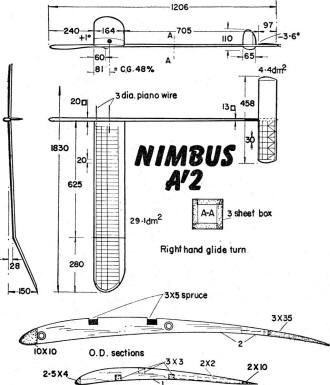
Bror Eimar's winning A/2 made 900 + 179 being also the winner of the
1960 Swedish Winter meeting with 900 seconds
In Power, Bulukin dropped first, as his model did not recover in time after a series
of stalls after engine cut-out. Next round, Finland's Nurininen dropped below the 4 minute
mark, so there were only Osmo Niemi, Jokinen and Hagel to share the three top places.
Niemi flew first, but somehow his model did not gain its normal altitude and he lost
18 seconds from the required 4:30. Hagel was next. His model made a fine climb, but the
motor run was so close to the upper limit of 15 seconds, that it took a long time before
the official timekeepers clocks had been compared to approve the flight.
It exceeded the 4:39 mark and Finnish hopes were now on Jokinen, but his elegant model
did not make its best climb and it returned only 4:05 so making Hagel well-deserved winner
with his original, long, three finned "Mister Max". Thus the toughest ever Nordic Countries
meeting concluded as the sun was descending to the horizon. The organisers had made everything
function correctly and deserved all praise. Competitors were also satisfied with the
day, although all had not experienced their best day, Finland demonstrated that, for
the third year in succession it is the leading country in free flight among the Nordic
Countries. In 1958 Finland won everything in rain and strong wind, 1959 saw a strong
thermal competition where the Finns took 6 of the possible 7 victories and now they gained
5 of 7 possible.
Sweden was also satisfied with the two personal victories, and Norway showed itself
to be fast making its way up to the leading aeromodelling countries in the Northern Hemisphere.
As to the models, beginning with A/2, it was very interesting to see three A.P.S.
"Sans Egal's" being well flown on the Finnish soil by their Norwegian owners. As they
said, the design is gaining a great popularity in Norway. The Finns were using highest
aspect ratios and small pylons in their models (made for inserting D.T. Timers in the
fuselage). The winning model by Eimar of Sweden was three years old, but is just beginning
to gain victories including the Swedish winter meeting with 900 seconds. The models of
fairly simple construction having silk covered two piece wing joined together with two
wires going through the slim fuselage.
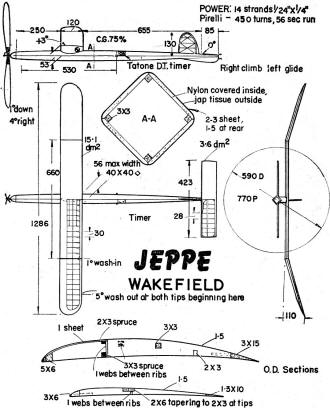
Winning Wakefield by Reino Hyvarinen made 900 + 210 + 240 seconds
In Wakefield the Swedes were using minimum sized compact models with small props and
short motor runs varying from 32 seconds in the Qvarnstrom brothers models, to 43 seconds
by Rene Johansson. The Finns were however taking advantage with their longer and higher
aspect ratio winged, big-prop, models having motor runs from Aalto's 40, Hamalainen's
46 to Hyvarinen's 56 seconds. The latter's model, winner of numerous competitions, has
a 4 year old prop and wing. He was the only Wakefield flyer using a clockwork d/t timer.
All power models were using the common pylon, the Norwegians having the lowest pylons.
Hagel and the Norwegians had two piece wings for transportation. Common engine choice
was the modified Oliver Tiger Mk. III, one flyer had Webra Mach I and another was using
Enya 15D. Osmo Niemi's Pulteri, which will join the A.P.S. plan range was admired for
two reasons, being the most straightforward and simplest construction, and also for having
a really fine performance. As the Swedes said, his model went up like a "train on rails",
so steady and effective was its spiral climb. Hagel had the most original designs, his
magnificently built winning model was featuring double fins and a third fin for auto-rudder
operation also using a clockwork d/t timer.
Posted July 10, 2016
|